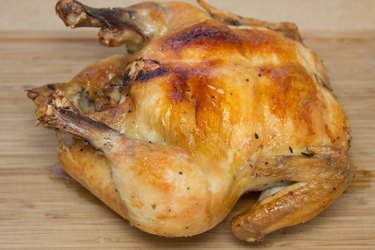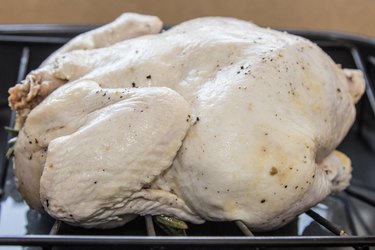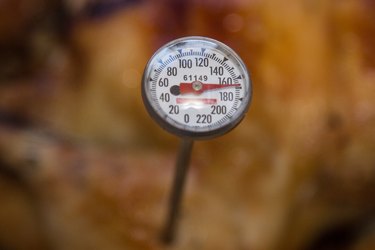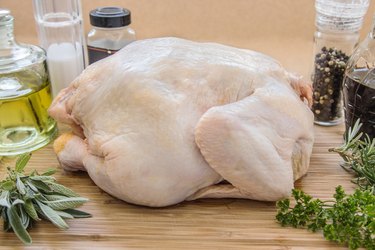
A capon is a castrated chicken that is widely considered to be more tender and flavorful that its counterparts in the supermarket. The capon is either the result of surgical castration or, in large commercial operations, induced with hormones. Capons labeled "all natural" have been surgically castrated. The birds tend to grow larger (up to 10 lbs.) and have a higher fat content than normal roosters.
Upside-Down Capon
Video of the Day

To roast a tender capon, place the bird breast-side down in a roasting pan. Because of the higher fat content, roasting a capon in this manner allows the juices to flow with gravity toward the breast meat, enhancing the flavor and further tenderizing the poultry as it cooks. Cook the seasoned and stuffed (if desired) bird at 450 degrees. Remove the bird after half an hour and turn the capon breast-side up, then dial down the oven temperature to 375 degrees. While the oven is cooling for the long roast, baste the capon in its own juices from the first 20 minutes of cooking.
Video of the Day
Cooking Time

Capons require longer cooking times than typical chickens because of their larger size. Roasting capons at lower temperatures helps bring out the flavor, but adds to the cooking time. As a general rule, a capon should be roasted for 17 minutes per pound, so a 10 1/2 lb. bird would require a total roasting time of just under 3 hours. The poultry is done when a meat thermometer inserted into the thickest part of the capon's thigh reads 170 degrees and the juices run clear.
Seasoning

Rub a mix of herbs and spices over the capon to seal in the juices and keep the skin from scorching during long roasting times. After rinsing the bird and placing it on a tray, pat down the skin with paper towels, then rub a quality olive oil over all the capon. Herb and spice rubs are limited only by your imagination, but good choices include sage and black pepper, lemon zest and tarragon, and any of the variety of curries if you are preparing an Indian dish. Rub the mixture into the skin. Make slits in the breast meat with a sharp knife to help the herb rub penetrate the poultry during the roast.